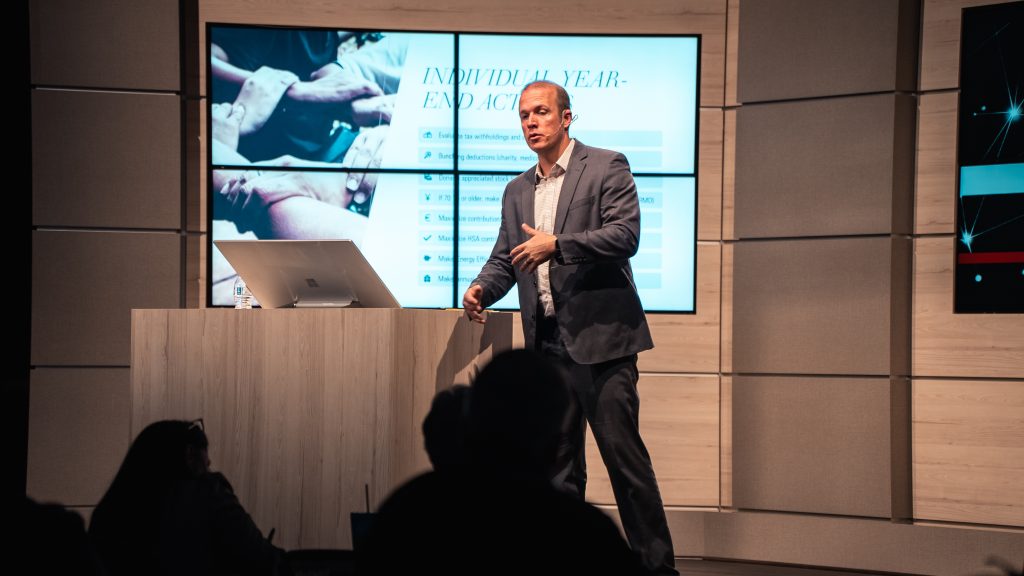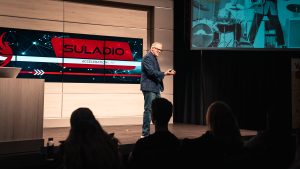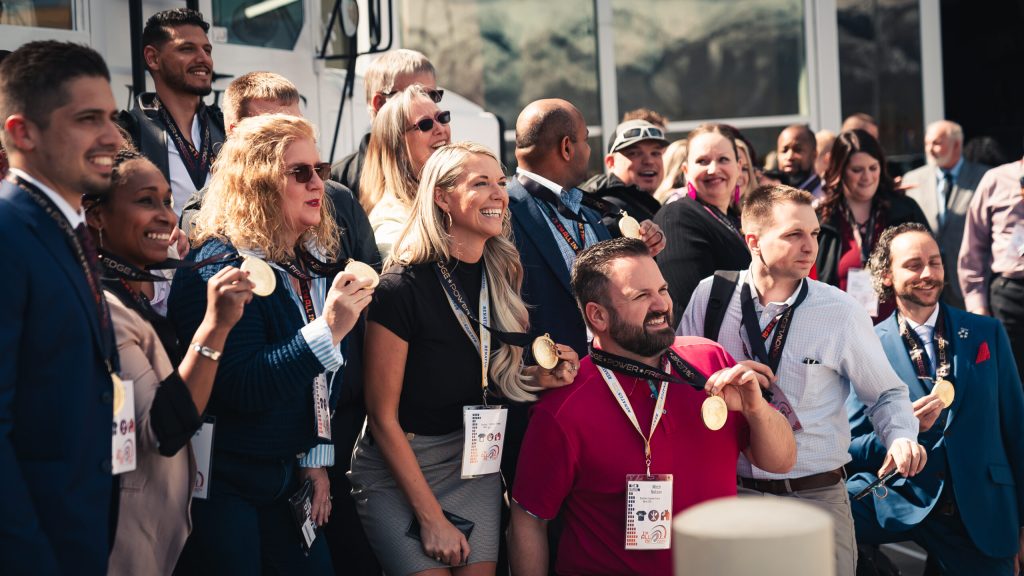Video Transcript:
J Stark: [00:00:00] So we just to recap for everybody are talking about the D.R.I.V.E sales book and on the back of the book it says there are five buying personalities and you naturally speak only one, just 20% of your audience. Woody, I would love for you to talk a little bit about what that means in the world of sales.
Woody Woodward:
So identify the five buying languages of D.R.I.V.E.
D is for directors. They’re motivated by freedom, creativity, and lifestyle. R is for relators. They’re motivated by community connections and relationships. I as intellectuals, they’re motivated by systems, knowledge and learning. V is validators. They’re about acceptance, respect, and trust. And E is executives. They’re about proof winning and they’re the show me the money audience. So when it comes to sales, inherently we all speak one, we have a native D.R.I.V.E, one that belongs to us. In that process, you accidentally and not on purpose, offend the other four, which is 80% of your sales. So just by opening your mouth, you lose 80% of your sales.
J Stark: So Bob, you’ve been involved in professional sales for almost 40 years. Correct.
Bob Snyder:
That I [00:01:00] have. That. I have.
J Stark: So tell me, what’s the difference that D.R.I.V.E has made in your sales career, in the way that you’re able to communicate and, and motivate people to buy?
Bob Snyder:
Whenever you have an opportunity to actually know what motivates an individual to make decisions, you cut the curve. You’re able to ask- you still have to ask the important questions, but you’re able to streamline those questions so that you get to the point a lot faster. In other words, it helps me to utilize the process of sales to generate a more predictable outcome. Which is helping the customer to sell themselves so that they make a buying decision and we all go home happy.
J Stark: Gotcha. So, Woody, what happens when there’s a mismatch in that communication language? I would love for you to talk a little bit, so in the, in the very first chapter of the book, you talk a little bit about James Cameron, Matt Damon, and about how James Cameron offered Matt Damon, the lead position in the avatar series, which we all know has been wildly successful. So tell me a little bit about what [00:02:00] happens when there is a mismatch and what, what maybe could have been done different to get Matt Damon on board.
Woody Woodward:
So all this pitch based on our D.R.I.V.E- so the way that we communicate, the way that we’re trying to convey our ideas to other people is based on our D.R.I.V.E.
So let’s say you’re from France, you speak French, and you go to Italy and you are communicating based in French. It doesn’t matter what your body language is. I don’t care how great you are at mining, you’re not gonna communicate properly. James Cameron, based on D.R.I.V.E, is a director so motivated by freedom creativity.
So he’s pitching to Matt, who’s a relator, all about community. All these fanciful beautiful ideas. You know this 10 foot tall, bluish green guys, and Matt’s there thinking, are you kidding me? Like, why would I do this? Like, you’re gonna wear all these blue dots on your body and you’re gonna act against a green screen, that’s not appealing to a relator.
If you look at Matt’s filmography, all of his movies are about connections, relationships. His best friend Ben Affleck, a lot of their movies are about community and connection and going deep. So even though [00:03:00] Avatar does have that, he didn’t pitch it that way. So he wanted Matt so bad, and Matt was coming off the success of the Born Identity. If you look at Avatar and the way it’s built, it is all about relationships. But the way that James Cameron pitched it, he pitched it like a director, this beautiful world, and these oceans and these flying pterodactyl type animals. And so when you’re getting pitched and you hear the wrong language, all you do is put up signs. “Well, I appreciate it. Thanks.” He ended up offering him 10% gross, not net- gross. The first two movies have done $5.4 billion. That would be $540 million Matt Damon would’ve made. But he missed it because he didn’t pitch in the right language.
J Stark: So, so I love the analogy of the foreign language when you go to another country and you, you’re speaking your native tongue, but that’s obviously not the language of the country that you’re in.
It doesn’t matter if you speak louder or quieter. It doesn’t matter how eloquent you are in your own language, Bob. Share. Do you have any examples from your life when you can think of, man, [00:04:00] I was, I was speaking so well, but just didn’t connect with this person, or maybe vice versa when somebody was speaking so well and didn’t connect with you.
Bob Snyder:
Well, I mean, fir, first of all, the real litmus test is when you’ve got a prospect or a client who said, you had me at Hello. You know that you’re resonating, you know you’re speaking their language, right? Otherwise, there’s always gonna be a disconnect. But I think about. Geez, so many sales things. You know, if you do it wrong enough, long enough, you kind of figure it out. What we’re trying to do is get people to cut the learning curve, and there have been so many times, especially early on in my sales career, where I would sit down with an individual and I would go into my pitch, right? I just went into my presentation. I didn’t do any investigation, I didn’t do any demonstration. I just went into my pitch because it was all about presentation.
And it was canned. It was, we start here, we go through this, and then we end up over here. And most of the time I lost them in the process because they were [00:05:00] bored out of their mind, or they felt like what I was sharing with them was totally, completely irrelevant.
Whereas if I’d have just spent some time asking questions, really getting to know them, finding out what their D.R.I.V.E was, and then being able to ask the right questions so that the prospect sold themselves. My closing percentage would’ve just gone through the roof.
J Stark: Alright, so Woody, I’m, I’m curious, in the, in the very first chapter of the book, you talk about, uh, a time when Google was for sale for $750,000. It got presented first to Yahoo and then to Excite, and I believe the, the CEO of Yahoo was, uh, Tim Kugel and the CEO of Excite was George Bell. And you talk about why it was that Google didn’t resonate with either one of them. So this is, this is not so much even a sales pitch now. This is like an opportunity. How many opportunities do we pass by on if they do not align with our D.R.I.V.E?
Woody Woodward:
We miss every single opportunity if it doesn’t resonate with our [00:06:00] D.R.I.V.E. Meaning we don’t see it for what it is. So if you look at the math, you look at the basic structure of the company, Google at $750,000 is a screaming deal. Just the technology alone would be worth it. But the president was an executive. He was all about winning control.
So if you look at Tim Kugel, he was an executive, meaning based on D.R.I.V.E, he’s about winning, having control. Yahoo at that time was the 10,000 pound gorilla. It was a monster. But then you see this little runt coming like, well, why do I want that? I’m already winning. I’m the biggest, baddest thing on the planet. But the technology that they had, if they would’ve presented it differently to Tim about how he could win, how he could leverage, how he could solve more problems, he would’ve bought it. And the first chapter is all about missed opportunities. There’s countless companies that are billion dollar companies now, even trillion dollar companies that could have been bought for millions or tens of millions. And there’s also billion dollar companies that now are bankrupt. Because they missed the opportunity. So when you’re presenting your ideas, you, you can’t present just on your D.R.I.V.E ’cause you’re gonna alienate 80% of your [00:07:00] audience.
J Stark: Yeah. And you know, speaking of that, Yahoo is still around, they’re still building growing. They’re maybe not as big or as dominant as they once were. However, they’re still, they’re still leaning forward, but Excite is all but extinct. Yeah, I haven’t heard that in a long, long time. So, so it’s just interesting how just being misaligned even that little bit, it’s really not going to allow people to open themselves to the opportunities.
So Bob, if somebody presents to you in, in a D.R.I.V.E language that is not your own, can you see past your own native language to, to find opportunity when people are speaking to you in a mismatched way?
Bob Snyder:
Here’s what’s so funny about it, because, because I have embraced D.R.I.V.E for over the last decade now, and, uh, it’s such a big part of me, I find myself helping the salesperson. You do that too? I
Woody Woodward:
I do it. I do it all time. The time I. Here’s how you sell me.
Bob Snyder:
Exactly. Yeah. I’m, I’m like, okay, let me give you a little backstory. Let me help [00:08:00] you to understand this. Let me help you to understand what I’m motivated for. Let me help you to understand what I’m really looking for. Here’s the challenges in my life.
Woody Woodward:
Yep.
Bob Snyder:
Here’s some of these situations. I’m like, and then I’m like, okay, so what have you got? And most of the time they still blow it. They, they still blow it. And then I’m like, no, no, no, no, no. You didn’t, you didn’t hear me. You didn’t hear me. Let me help you understand. You know exactly how to sell me. I am, I am just dumbfounded.
And, and, and the reason why is because the world of professional selling, something happened along the way, and it’s no longer professional selling. What it has become is novice order takers and those novice order takers are leaving a lot of money on the table. And what really my mission and goal is, is to help an individual understand how to get back to following a process that leads to a more predictable outcome.
J Stark: I see the novice order taker or the appointment setter.
Bob Snyder:
Yes. Yes.
J Stark: Those seem to be the two anymore. [00:09:00]
Bob Snyder:
And listen, you know, back in my day when I was coming up through the ranks, uh, it wasn’t uncommon for, for a salesman- and this was 35, you know, 40 years ago. Really good salespeople. They were knocking down, you know, 250, 300, $500,000, some of ’em over seven figures a year. They, uh, they the numbers of individuals that could literally go out there and transform their life through sales, and commission sales was huge. But order takers were individuals that were just sitting on the phone waiting for the order. They were in retail stores waiting for somebody to walk in. The commissions that they earned paled by comparison to outside salespeople. It’s still true today, but I see a lot more folks trying to emulate just the retail walk-in order taker and, uh, we’ve gotta change that.
J Stark: Love that. I love that. A direct quote from the first chapter is, “no matter how great an opportunity might seem, if it isn’t communicated in the right D.R.I.V.E language, it can easily be [00:10:00] dismissed.”
So Woody, what is your elevator pitch to D.R.I.V.E to really hit on all five D.R.I.V.E types?
Woody Woodward:
The elevator pitch for D.R.I.V.E is this: inherently there are five D.R.I.V.E languages. You speak one naturally, but you alienate the other four. When you learn to speak those other four languages, you have the potential to increase your uh, sales reach by 400%.
J Stark: Alright, so, so Bob, what are some of the consequences in your life if you don’t learn to adapt your D.R.I.V.E or your language to other people’s D.R.I.V.Es?
Bob Snyder:
Well, it, it’s, it’s a misalignment. It’s kinda like driving your vehicle down the road. I mean, if you’re misaligned then, then you’re driving at an angle and you’re trying to stay between the white lines. And uh, and that’s always a challenge. Because it makes for a, a less pleasant journey along the way. You also can’t go as fast, you can’t be as efficient, and, uh, you can’t enjoy the ride like you otherwise would.
Same thing is true with D.R.I.V.E. I, I, listen, I’m an executive validator and if I’m trying to sell to an individual who is maybe an intellectual relator, [00:11:00] I have got to speak their preferred buying language, not my preferred selling language. And if that’s misaligned, I’m gonna miss the sale. And they’re gonna wait for someone to come along that is aligned with them before they make that purchase. That’s how rapport is really built. See people like people like them, right? And it’s all about the trust and credibility factor. Well, the reason why an executive can get along with an executive is because they’re like each other. As salespeople, we’ve gotta be a bit of a chameleon. That means that what we’ve gotta learn to do is, is we’ve got to learn to speak their language, to build rapport so that they internally go, this persons like me. They understand me. I like them. I can trust them. They are immediately credible as a result of it.
J Stark: Mm.
Bob Snyder:
And that’s how we get sales done.
J Stark: That’s awesome. And I love that analogy because you know, you can still get a car that is misaligned to go straight down the street. It just takes a whole lot of correction [00:12:00] along the way.
Bob Snyder:
Yes, it does.
J Stark: You’re constantly trying to fight back and forth, and it’s gonna wear the tires out worse, it’s gonna wear out the car a lot worse, a lot quicker.
Bob Snyder:
And it’s gonna wear out your welcome very fast.
J Stark: Yes, it will. Yes it will. Um, Woody, you highlight a story in the first chapter that I love about Steve Jobs and Bill Gates back at a time when Apple was really struggling, and Bill Gates on top of Microsoft was absolutely crushing it. Now you, you use this as a great example of how Steve Jobs directly and deliberately altered his pitch to align with Mr. Gates and what was going on in his life. Can you tell us a little bit more about that?
Woody Woodward:
That’s one of my all time favorite stories. I call it the Perfect Pitch. It’s a story of Steve Jobs and Bill Gates, where in the early nineties, they were at each other’s throats. They hated one another, and they were constantly in the magazines and on TV just taking pop shots at one another. But during that same time, Steve Jobs gets kicked out of Apple. He starts Next Computers, he ends up buying Pixar from George lucas, [00:13:00] makes billions of dollars from Pixar, and then Apple comes back to him, says, Hey, we have 30 days left ’til we’re outta cash, will you please come save our company? Said, sure, I’ll come in. I gotta fire everybody on the board. Based off his D.R.I.V.E, that’s his revenge, he fires everyone on the board. Now he has to go raise $150 million. Apple doesn’t have it. There’s only one guy on the planet who’s liquid enough to do it, and that’s his arch nemesis: Bill Gates. So he’s gotta fly up to Seattle, meet with Bill. Imagine you gotta pitch your enemy to give you $150 million. This is in the nineties. That’s equivalent of what? 450 million today? Half a billion dollars. So Steve Jobs has to go to Seattle and he has to pitch Bill Gates, who’s an intellectual, the way that Bill wants to receive the information, not the way that Steve wants to deliver it.
So as an intellectual, it’s all about systems, knowledge- it’s about learning. He knew at that time that the US government was coming down hard on Microsoft for monopoly. So instead of pitching what Apple needed, he said, Hey, you are gonna be brought before the government. You’re gonna be, you know, tranched through and destroyed publicly. But if you [00:14:00] don’t help us, you will have a monopoly. Without Apple, you do have a monopoly. So if you’ll invest with us, we’ll give you shares, you’ll make money on your return. And he just started talking to ’em the way an intellectual wants to be spoken to. So he appealed to his D.R.I.V.E. That’s why I called the perfect pitch.
He got the $150 million. Both companies get saved. Microsoft didn’t have to be broken up into multiple companies, like a Standard Oil had to back in the what? 1920s and thirties when the government came after them for monopoly. All because Steve Jobs pitched perfectly based off of Bill Gates D.R.I.V.E.
J Stark: That’s an awesome example of exactly what, what crafting your pitch deliberately to somebody’s D.R.I.V.E can do for you. And I know it’s not talked about in the first chapter, but Bob, you do a phenomenal job of really being able to adapt your message quickly to individual’s D.R.I.V.Es. What are some of the best ways that you’ve picked up on, on how to how to really assess what somebody’s D.R.I.V.E is?
Bob Snyder:
You know, when you say really quick, then of course [00:15:00] it’s what, what he always teaches you is the conversation close. You know, where you’re gonna ask them, um, you know, besides work and family, what is it you’re most passionate about? Because in the process of them answering that question, they’re gonna real reveal a little bit about themselves and they’re gonna reveal what is important to them.
So then you can kind of hone it down and, and get a better feel for where things are at with D.R.I.V.E. The cards are fantastic. ’cause you can take the D.R.I.V.E cards and you can lay them out and you can just say, Hey, do me a favor, you know, identify the, uh, the, the cards that have the most words on them that make you feel important- not what’s important to you, but what makes you feel important. I. And then by organizing the cards, you can get a feel for whatever their primary and secondary D.R.I.V.E is too.
But I’m here to tell you the very best way is to get them to take the assessment. Now, there’s a lot of folks who say, well, how do you do that in a sales call? I mean, get somebody to take an assessment, right? First. Uh, I found that you gotta go in and build a relationship with the individual. And as you built a relationship of trust and [00:16:00] you demonstrate the fact that you are a professional and that you’re there to help assist them in solving problems, meeting their needs, and receiving an outcome that is most beneficial. A lot of times people will say, well, you’ve gotta sell the benefits, the benefits, the benefits. Really what you’re selling is a result. That’s what you’re selling, right? After you’ve built a relationship, it’s easy for me to say, you know what? Here’s one of the tools that I use to really help my clients, because I don’t want you to be a one-time customer. I wanna build a relationship over time so that you become a client and eventually a raving fan. And the only way that I’m able to do that is, is that I use this incredible tool to identify your D.R.I.V.E. And I’ll explain a little bit about D.R.I.V.E, and I’ll say, if you just take five minutes, five minutes and take this assessment, you’re gonna get some results that are gonna be revelatory for you in terms of what your true motivations are, but it’s going to then help me to better understand how to serve your needs, not [00:17:00] just today, but long-term.
I have had over the years, very, very few individuals who weren’t willing to go through that exercise because if I can’t sell them, I can’t serve them. If I can’t sell them, I can’t help them. If I can’t get them to take the D.R.I.V.E assessment, so I’m clear on what their D.R.I.V.E is, then I’m gonna be limited in my capacity to really serve the needs of that customer.
J Stark: I love that. That’s a fantastic way to, to, to look into really serving and helping that individual.
Bob Snyder:
And that’s where you’ve gotta come from. I mean, if, if you’re coming from, from a position of, okay, this individual represents dollars to me and my family, then you’re gonna show up inauthentically, you’re gonna show up manipulative. And, uh, they’re gonna sense that, and it’s gonna build that sales resistance that we want to avoid at all costs. If on the other hand you show up saying, Hey, I wanna be your friend. I wanna be your support. I wanna be, you know, your solution, um, individual, I wanna be a partner with you in helping [00:18:00] your company grow, then it, it, it leaves you in a much different position with the customer. And I think most folks, they’re just going in to grab attention and pitch ’em on whatever they’ve got. Man, I want to go in and build a long-term relationship, and it starts with day one.
Speaker: Awesome.




